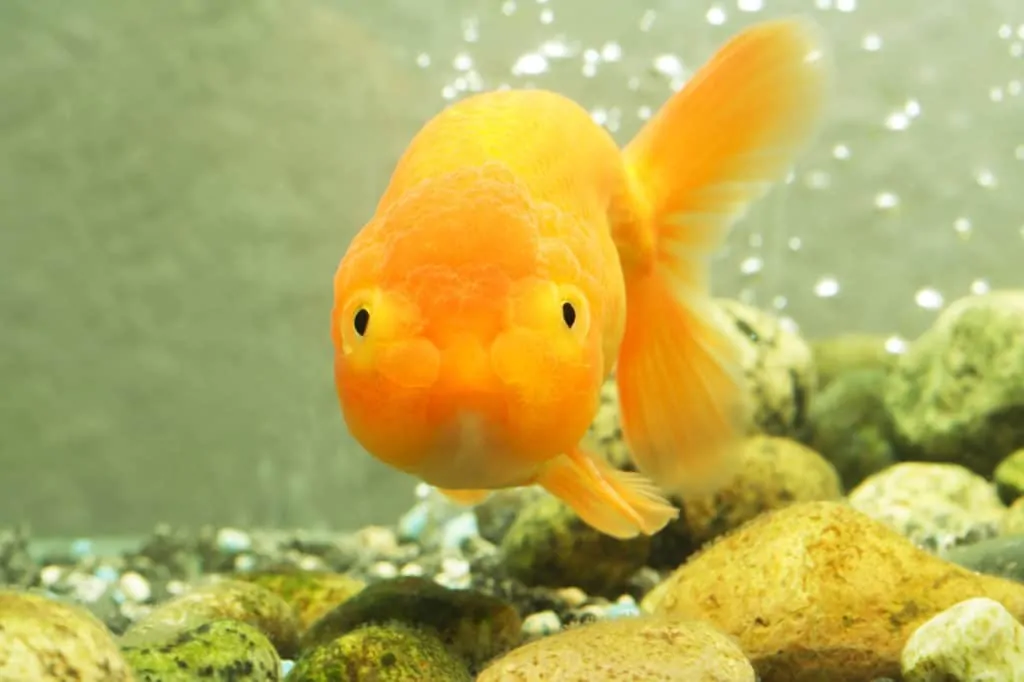Goldfish make great starter pets for kids and are often an enthusiast’s first venture into the exciting world of fishkeeping. There are many different varieties of goldfish, and lots of different colors and shapes to choose from.
Goldfish are hardy and generally pretty easy to care for, too, making them the ideal choice for a beginner.
In this guide, we take a look at the unusual and bizarre-looking Lionhead goldfish.
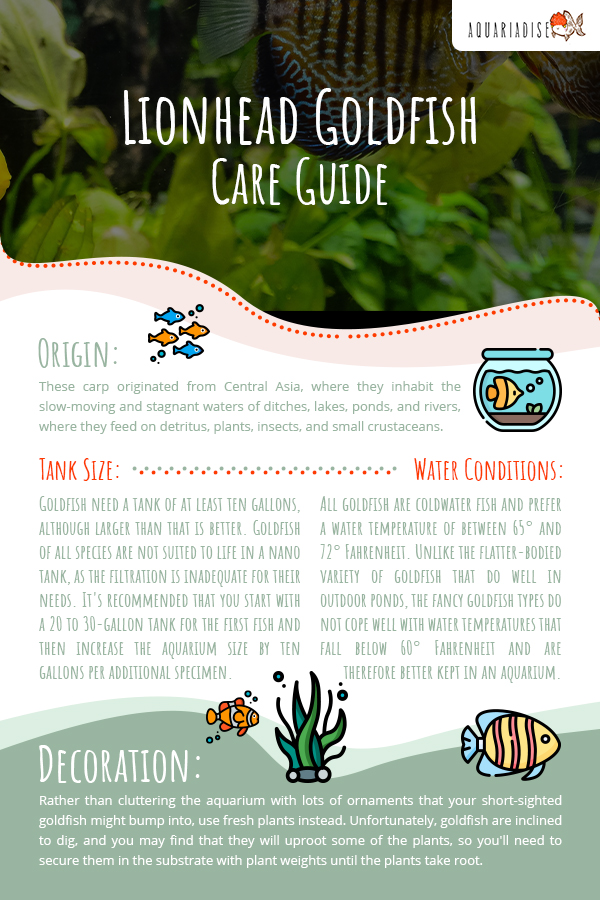
Origins
All modern goldfish are descended from a species of wild carp, Carassius gibelio, or Prussian carp.
These carp originated from Central Asia, where they inhabit the slow-moving and stagnant waters of ditches, lakes, ponds, and rivers, where they feed on detritus, plants, insects, and small crustaceans.
China developed the first fancy varieties of goldfish, trading them into Japan by the 1500s. Goldfish arrived in America in the 1800s and in Europe in the 1600s. Modern goldfish are found worldwide, and there are no fewer than 125 captive-bred varieties that have been developed through selective breeding.
The Lionhead goldfish is one of the oldest fancy goldfish varieties. There is no wild population of this goldfish, and all the specimens that you’ll find in pet stores are captive-bred.
Lionhead goldfish appearance
Lionhead goldfish, scientific name Carassius auratus auratus, is the most popular and well-known of the family of dorsal-less, Oranda goldfish.
These fancy goldfish lack a stabilizing dorsal fin, and that trait is also seen in the Celestial Eye goldfish and the Bubble Eye goldfish.
Lionheads are shaped much like Fantail goldfish, having egg-shaped bodies and short, double tail and anal fins that gradually grow into a floating, fan shape. Although they are very rare, you can sometimes find long-finned varieties of Lionheads.
Lionhead goldfish were bred in China to develop a curious-looking “hood” that is meant to resemble the image of the mythical Chinese lion-dog. As the fish grows and develops, it develops a raspberry-like growth on its head that looks a little like a lion’s mane, hence the fish’s common name.
The weird head growth varies between individuals. In some examples, the fish’s head is covered completely, except for the mouth, nostrils, and eyes. Other fish will develop barely any head growth at all.
Lionheads can grow to over ten inches in length, although the more usual size is closer to five inches. The lifespan of the fish is between ten and 15 years, although living for over 20 years is not uncommon in clean, well-maintained ponds and aquariums.
Ranchu goldfish
The Ranchu goldfish is a variant of the Lionhead that was developed in Japan. Ranchus are also a type of Oranda goldfish, having a more curved back than that of the Lionhead.
The Ranchu’s caudal fin splays out to the sides and is often pretty much horizontal.
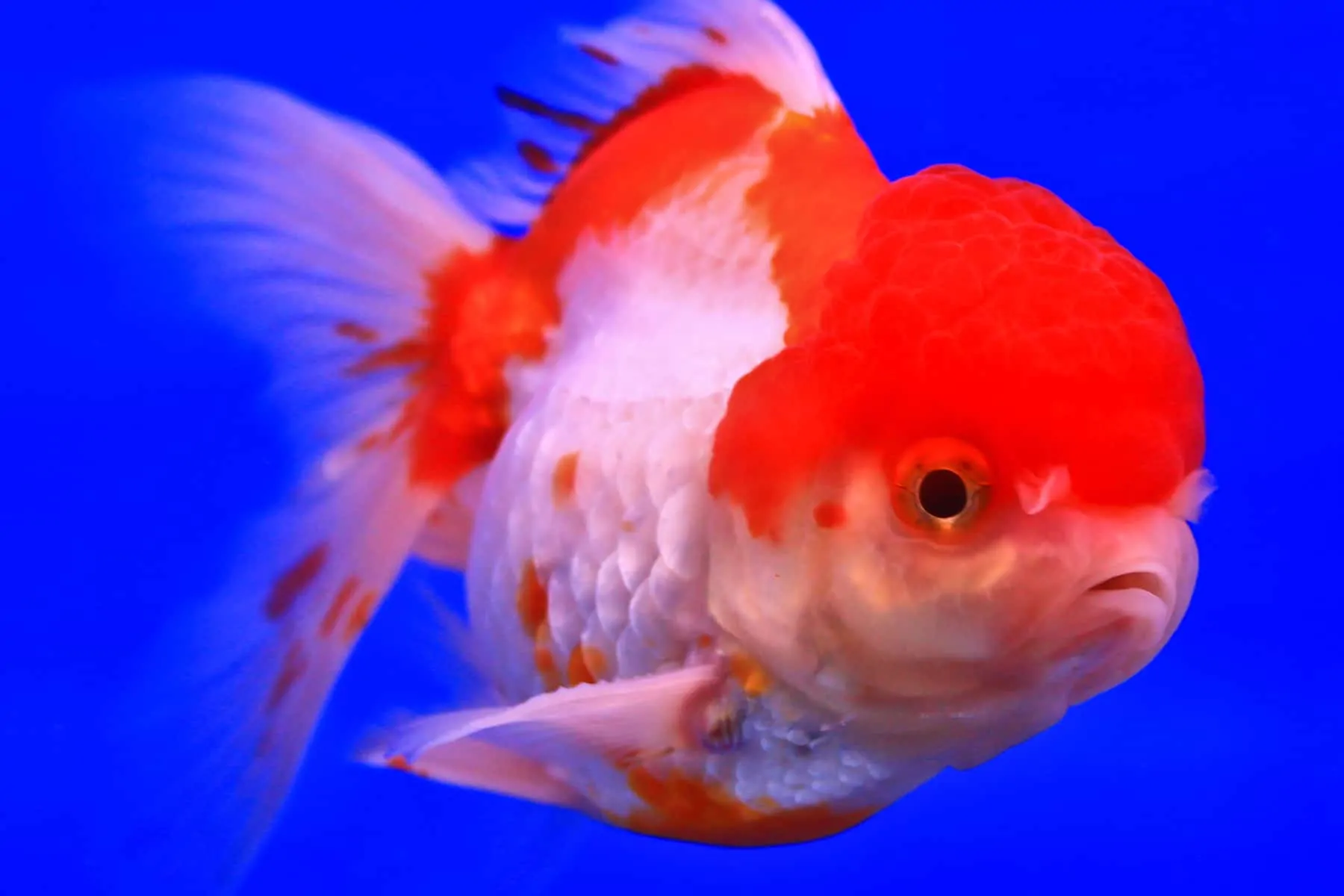
Redcap Oranda goldfish
Recap Oranda goldfish are often confused with Lionheads, although the two varieties are quite different.
Recap Orandas also come in orange, chocolate, black, and blue, as well as bi-colored, calico, red and black, red and white, or even tri-colored in black, white, and red. Although their body shape is similar to that of the Lionhead, the Redcap Oranda has a dorsal fin and lacks the bubbly growth around the face.
Care of the Lionhead goldfish
Of all the species of goldfish that are commonly available, the Lionhead is one of the most delicate in that they cannot tolerate a polluted living environment. That means you must have a proper aquarium with filtration and lighting, rather than a simple bowl.
Tank size
Lionhead goldfish can grow up to ten inches in length, although five inches is more common. However, you will need to provide a large tank to accommodate the fish’s growth.
Goldfish need a tank of at least ten gallons, although larger than that is better. Goldfish of all species are not suited to life in a nano tank, as the filtration is inadequate for their needs. It’s recommended that you start with a 20 to 30-gallon tank for the first fish and then increase the aquarium size by ten gallons per additional specimen.
As a general rule of thumb, you should allow one inch of fish per one gallon of water. However, larger goldfish consume more oxygen than smaller, younger specimens. If there’s not sufficient room for juvenile fish, their growth may be stunted, potentially causing disease and even resulting in death.
Fancy goldfish are not good swimmers, so a long tank is better than a tall one. Also, a long tank provides more surface area and, therefore, more oxygen for the fish.
Water parameters
All goldfish species are dirty characters that produce a large amount of waste, so you must have an efficient, biological filtration system. Also, you’ll need to carry out 40% water changes every week.
Since Lionheads are poor swimmers, you should keep the water movement in the tank down to slow or moderate. If the fish are buffeted around by a strong current, they will become stressed and more susceptible to disease. Goldfish need plenty of space to swim in all areas of the water column, so try to buffer the flow with decorations or planting to prevent upsetting the fish.
All goldfish are coldwater fish and prefer a water temperature of between 65° and 72° Fahrenheit. Unlike the flatter-bodied variety of goldfish that do well in outdoor ponds, the fancy goldfish types do not cope well with water temperatures that fall below 60° Fahrenheit and are therefore better kept in an aquarium.
The water pH should be in the range of 6.0 to 8.0 with a hardness of between 5 and 19 dGH.
Aquarium decoration and setup
The tank should have a gravel substrate and some smooth rocks or driftwood that won’t snag on the Lionhead’s floating finnage.
Rather than cluttering the aquarium with lots of ornaments that your short-sighted goldfish might bump into, use fresh plants instead. Unfortunately, goldfish are inclined to dig, and you may find that they will uproot some of the plants, so you’ll need to secure them in the substrate with plant weights until the plants take root.
Also, if algae are growing on your live plants, you may find that the goldfish will eat the algae, shredding the plant leaves in the process.
You can use silk plants as a substitute, but avoid plastic ones, as they can have sharp edges that could cause injury to your fish.
Lighting is not essential for goldfish, but it does help to create a beautiful display, and light will encourage plants to grow. Although fancy goldfish are not known for jumping, you should choose a tank that has a cover slide or tightly fitting lid to prevent water evaporation.
Diet and feeding
Goldfish are omnivorous and will eat pretty much anything. You can feed the Lionhead goldfish a diet of fresh, frozen, flaked, and pellet foods, and they will also graze on certain species of algae in the aquarium.
However, like all round-bodied fantail goldfish varieties, constipation can be a problem for Lionhead goldfish. If you discover your fancy goldfish floating up to the top of the tank, apparently unable to descend, it’s most likely constipated. The fish’s round body shape can sometimes hamper food from passing through its intestines, causing a blockage that affects the fish’s ability to balance itself and swim properly.
You can help to prevent the condition by feeding the fish pellets or flakes that are specially formulated for round-bodied goldfish. It’s also helpful to include a daily portion of frozen or live bloodworms or similar, which are very effective at preventing and relieving blockages.
Ideally, you should feed your goldfish several times a day, giving only small amounts at each feed. Because Lionheads often have poor eyesight, you should allow them extra feeding time.
Tankmates
Like most fantail goldfish, Lionhead goldfish are not strong swimmers and can be further encumbered by their lack of stabilizing dorsal fin. Also, the Lionhead’s vision can be compromised by the growth on its head, causing the fish to bump into things in the aquarium environment.
Goldfish varieties with elongated bodies are fast swimmers and don’t make good tankmates for the Lionhead, as they can be too competitive at feeding times. Better choices include Bubble-Eye, Telescope, Celestial, and Fantail goldfish, all of which are similar in swimming ability to the Lionhead.
All varieties of fancy goldfish are peaceful and get along well together, and you can create a really attractive display by having a mixture of colors. For example, the black oranda goldfish is a variety that looks stunning against the red or red and white of a pair of Fantails.
Snails can make a useful addition to the aquarium as they help to keep the environment clean by eating algae and detritus that they find by foraging through the substrate. However, although some species of shrimp will happily live in cooler conditions, goldfish are voracious feeders and will eat, or attempt to eat, anything that they can fit into their mouths. So, small shrimp would most likely become lunch for a large Lionhead.
Breeding
Given the correct care and conditions, Lionhead goldfish will spawn readily in captivity.
Sexing Lionhead goldfish
If you want to breed from your Lionhead goldfish, you will need to know how to tell the sexes apart. Unfortunately, it is virtually impossible to do that in juvenile fish and outside of the breeding season. However, in mature Lionhead goldfish, the male is generally more slender and less rounded in shape than the female.
During the spawning season, the male develops white prickles on its head and gill covers. These strange growths are called breeding tubercles. When viewed from above, the female will appear fatter in shape when she is laden with eggs.
Breeding tank setup
In the wild or in a garden pond environment, all goldfish species spawn during the springtime when the water temperature warms up to around 68° Fahrenheit. Goldfish are egg layers, and they will happily spawn in large groups of five or more.
To encourage spawning in the aquarium, you need to replicate the conditions that the fish enjoy in nature. It’s also best to set up a separate breeding tank for the goldfish.
The aquarium should be at least 20 gallons, and the fish must be healthy and free from disease. Create a lush environment with plenty of plants and some solid surfaces to which the eggs can adhere. You can use spawning mops if you prefer.
It’s helpful to separate the male and female fish for a week or two prior to breeding, as that can increase their interest in spawning. Put the male and female fish into the breeding tank at the same time, and reduce the temperature within the aquarium to around 60° Fahrenheit.
Slowly warm the water at a rate of 3° Fahrenheit each day until the fish begin spawning, which usually happens when the aquarium temperature reaches between 68° and 74° Fahrenheit. Keep the water clean by carrying out partial water changes of up to 20% each day.
Feed your fish a generous high-protein diet, including live brine shrimp and bloodworms. Feed the fish three times a day, offering them small amounts, being careful not to overfeed them.
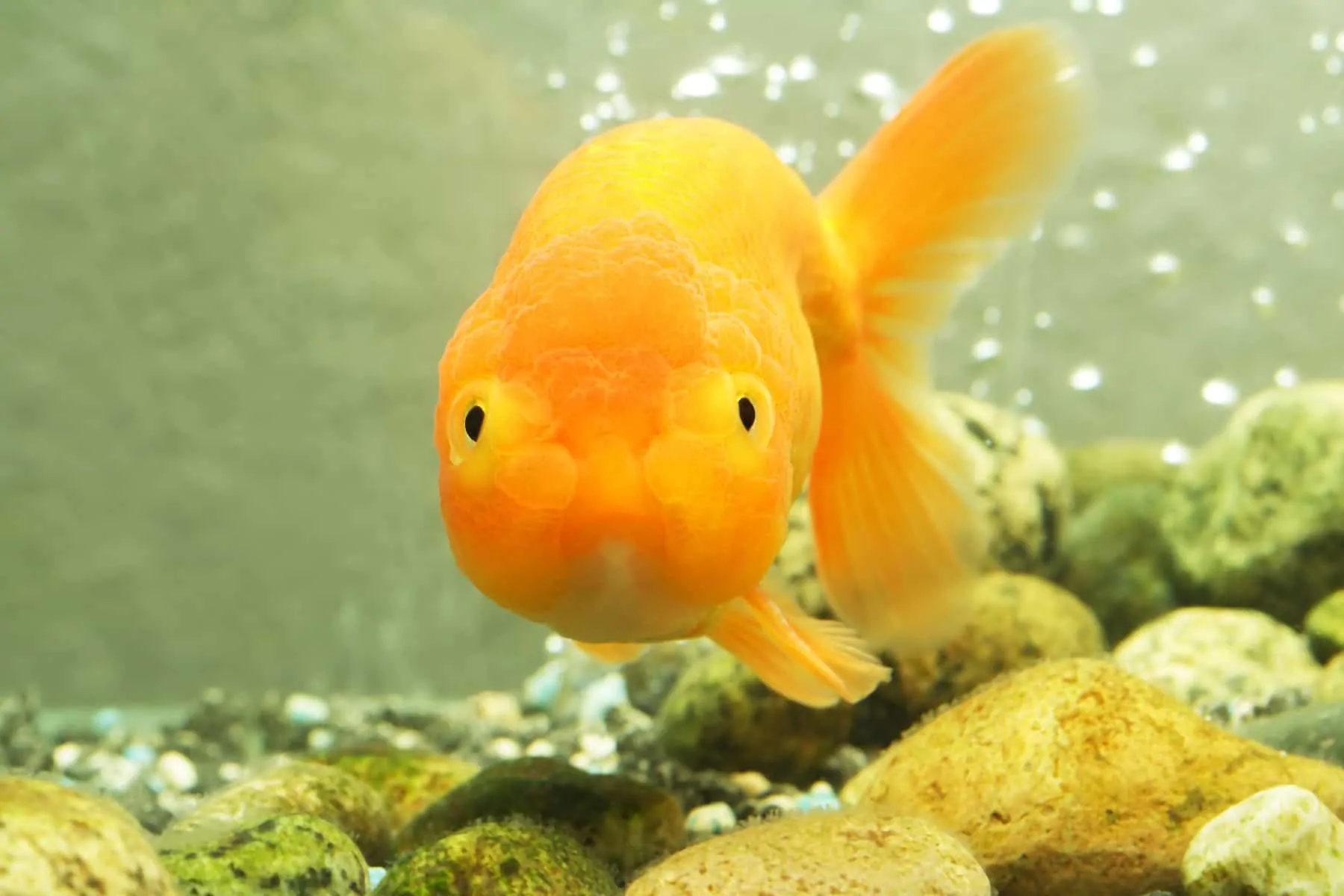
Spawning behavior
As the temperature in the aquarium increases, the male will pursue the female. That behavior will continue for a few days, and you’ll see that the fishes’ color will begin to intensify.
During spawning, the male will push the female against the plants, and both will gyrate from side to side. That activity stimulates the female to lay tiny eggs, which the male then fertilizes. The spawning process lasts from two to three hours, producing as many as 10,000 eggs.
Once spawning has ceased, you must remove the parent fish from the tank right away before they have a chance to eat the eggs.
The eggs are sticky and will adhere to the spawning mop or plants, where they will stay until they hatch a week or so later.
Raising the fry
Once hatched, the fry can be offered a diet of specialty goldfish fry foods. Once the fry is large enough, they can be fed brine shrimp or flake. You can also feed the fry the same foods as the adult fish, provided that you crush it into very small pieces.
When they are first born, the fry is black or dark brown in color, rather than red or red white. That’s to help the baby Lionheads to avoid being predated on by larger fish. After a few months, the youngsters take on their adult coloring and grow to around an inch long. At this stage, the fry can be added to a tank containing mature, larger fish.
Diseases
Although goldfish are pretty hardy creatures that will remain healthy and disease-free, provided that you keep their tank clean and feed them correctly, they can be susceptible to some common freshwater fish illnesses.
The main problems for Lionhead goldfish include fungal and bacterial infections, protozoa, and parasites, as well as injury and sickness caused by poor water conditions.
Protozoa
Ich is a very common protozoan disease that’s caused by the activity of a parasite called Ichthyophthirius multifiliis.
Ich is often known as White Spot disease and generally occurs when the fish become stressed, for example, following shipping or when water conditions within the tank are poor. Affected fish develop a rash of tiny white spots on the body, fins, and gills. If left untreated, the gills become clogged with parasites, and the fish ultimately suffocates.
You can treat Ich and other protozoan diseases, including Costia and Chilodonella, using over-the-counter water treatments that you’ll find in most aquarist stores and some pet shops.
External parasites
External parasites such as flukes, fish lice, and anchor worms are quite common in Lionhead goldfish. These parasites are usually visible to the naked eye attached to the gills or body of the fish.
Again, all these parasites can be killed by using dips or adding suitable preparations to the tank water.
Bacterial and fungal infections
There are a variety of bacterial infections that can be fatal to your Lionhead goldfish if not treated quickly.
These conditions include:
- dropsy – a kidney infection
- tuberculosis
- fin rot
- fungus
Swim bladder disease
All types of round-bodied fancy goldfish are prone to swim bladder problems.
Fish affected by the condition have problems maintaining their balance and in swimming. Usually, the condition is caused by constipation and is easily cured by feeding the fish more frozen or live food, as opposed to a diet that consists solely of flakes or pellets. In addition, you can offer the fish a few cooked peas, which can help to clear an intestinal blockage.
Wounds and ulcers
Because of the raspberry-like growth on the head of Lionhead goldfish and their poor swimming ability, they can be prone to sustaining injuries through bumping into things in the aquarium.
If a wound becomes infected, it may morph into an ulcer. Ulcers often develop fungal or bacterial infections that must be treated. As with many of the aforementioned conditions, ulcers can be treated with over-the-counter antibacterial products that you’ll find in your local fish store or online.
Disease prevention
The easiest way of preventing disease outbreaks in your aquarium is to place any new specimens in a quarantine tank for at least two weeks before adding them to the main display setup. New plants and ornaments should be washed in a solution of antibiotic treatment before you add them to the aquarium.
If you take care not to accidentally introduce parasites or bacteria to your setup, your fish should stay healthy.
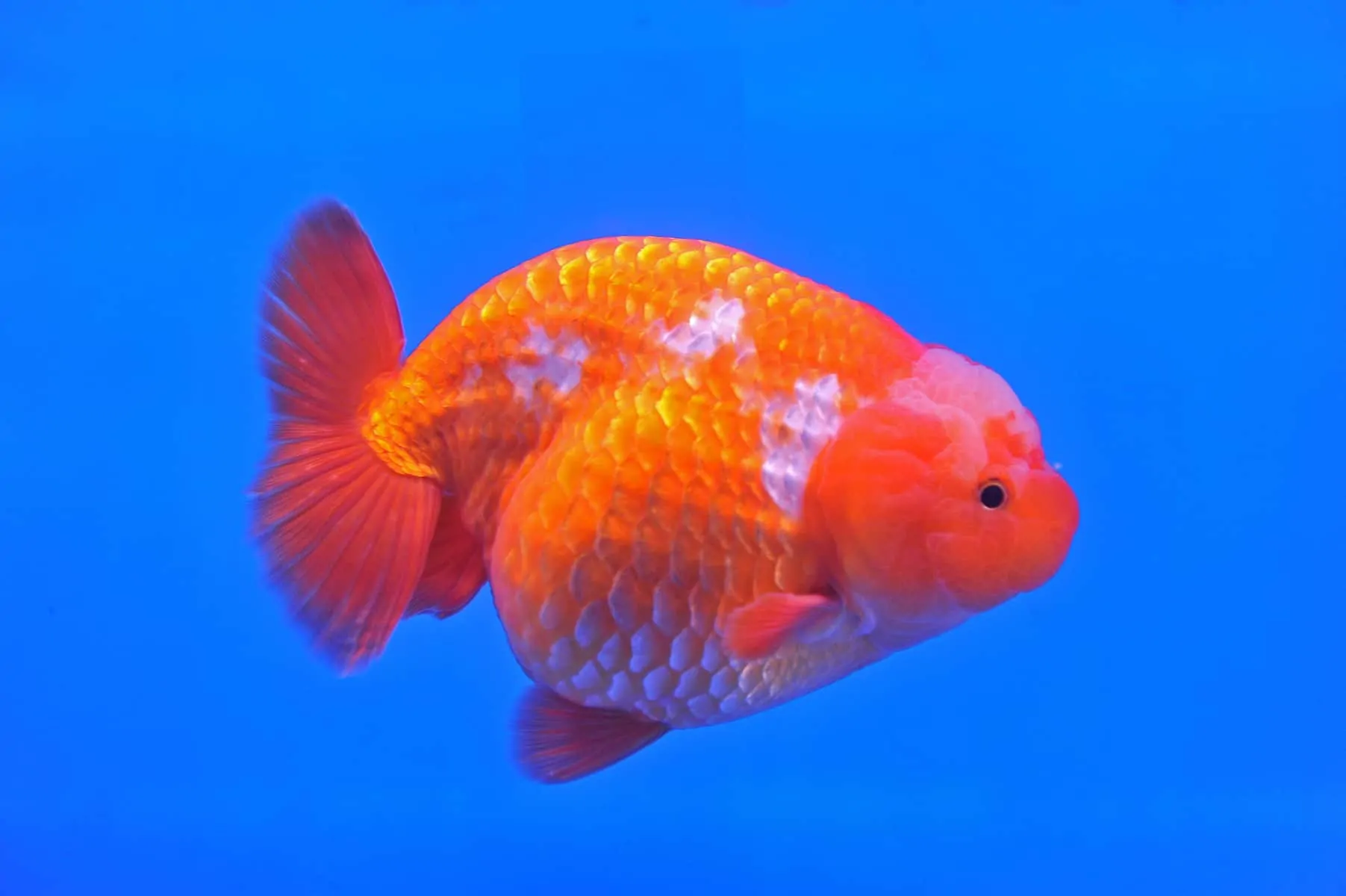
Availability
Lionhead goldfish are usually available from most aquarium stores and online, costing around $3 per fish.
Some stores offer deals on goldfish if you buy a small group of specimens. Remember that online suppliers will apply a shipping charge to your order.
FAQ
In this part of our guide, we answer a few of the most commonly asked questions about Lionhead goldfish and their care.
Q: How long do Lionhead goldfish live?
A: Given the right care and a good diet, the Lionhead goldfish can live between ten and 15 years, although some specimens have been known to survive for 20 years and more, even outliving their owners!
Q: What fish can live with Lionhead goldfish?
A: Lionheads are coldwater fish. These creatures are very slow, clumsy swimmers that do best when in the company of their own kind or with some other variety of round-bodied goldfish, such as Bubble-eye, Oranda, or Telescope goldfish.
Avoid mixing round-bodied goldfish with long, streamlined varieties. These fish are very fast swimmers and may prevent the Lionheads from getting enough food.
Q: Can Lionhead goldfish live in ponds?
A: Lionhead goldfish can live in ponds, provided that the temperature does not drop below 60° Fahrenheit. These fish are more delicate than other varieties, as they are not good swimmers, and the growth on their heads can impair their vision.
Q: What is the difference between Ranchu and Lionhead goldfish?
A: The Ranchu goldfish is a type of Oranda that originates from Japan, whereas Lionheads come from China. Ranchus have a more curved back than the Lionhead and also have a caudal fin that splays out to the sides and is often pretty much horizontal.
Final thoughts
The Lionhead goldfish is an unusual variety of coldwater fish that’s distinguished from other round-bodied Oranda-type fish by the curious, raspberry-like growth on its head, and its lack of a dorsal fin.
These eye-catching fish can be kept in a large tank with other Orandas or even in a pond provided that the water temperature doesn’t fall below 60° Fahrenheit.
Although goldfish are often thought of as a pet for kids, the Lionhead does need some special care to keep him healthy and happy. Follow the guidelines in this article, and you can look forward to enjoying up to 20 years in the company of your Lionhead goldfish!

